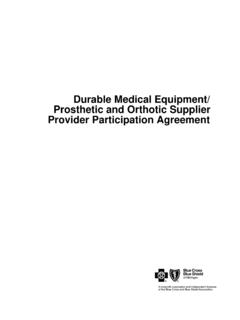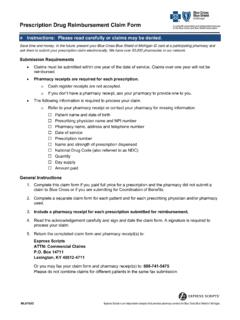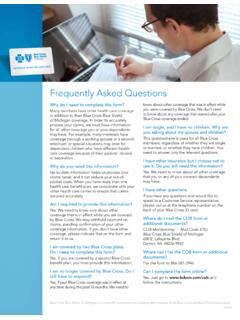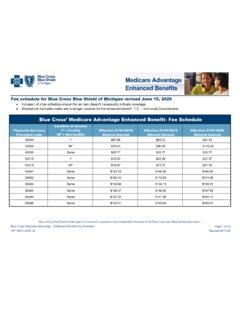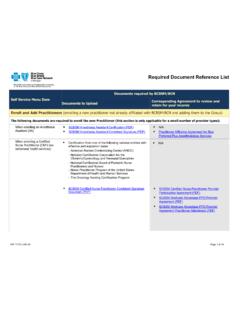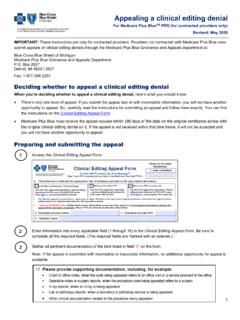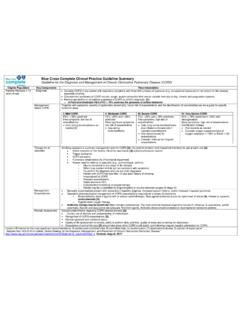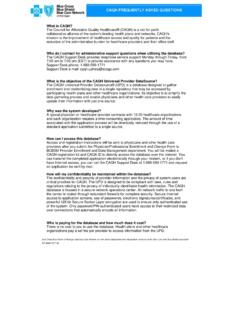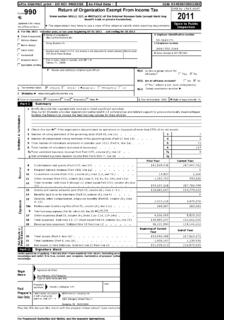Transcription of Building Healthy Communities - bcbsm.com
1 Building Healthy Communities : step Up for School Wellness 2016 2017 Request for Applications Applications due: September 30, 2016 More information can be found at Welcome to Building Healthy Communities : step Up for School Wellness! Blue Cross Blue Shield of Michigan, Michigan Department of Education, Michigan Department of Health and Human Services, Michigan Fitness Foundation, Michigan State University Extension, Michigan Team Nutrition, United Dairy Industry of Michigan and Action for Healthy Kids have partnered to create a school-based program Building Healthy Communities : step Up for School Wellness that supports childhood wellness. The program empowers school leaders to build a Healthy school environment that leads to a culture of wellness. A culture of wellness is present when members of a community consider health and well-being a priority. Why is this important in schools? There is a positive connection between health and academic achievement. A positive school culture that includes an emphasis on wellness builds a culture of success.
2 Program goals for participating schools Build or re-energize a School Health Team. Assess the school health environment using the Healthy School Action Tools (HSAT). Empower students to make Healthy choices that include fruit, vegetables, low-fat dairy, whole grains and lean protein every day. Empower students to be more physically active every day. Evaluate, sustain and share successful implementation strategies. 2 2 Program overview The Building Healthy Communities : step Up for School Wellness program provides students , teachers and administrators with the tools they need to create a Healthy school environment that supports a culture of wellness. This program integrates the recommended process from Michigan s new Steps to a Healthy School* website and uses the same five action-focused steps outlined below. The Building Healthy Communities : step Up for School Wellness program also allows schools to: Choose two or more components to improve the school environment.
3 Choose at least one physical activity or physical education component and at least one Healthy eating or nutrition education component from seven options. Receive the training, curriculum, resources, communication tools and equipment needed for successful implementation of their chosen components. Focus Area 1: Physical Activity and Physical Education Classroom Physical Activity Breaks Active Recess Quality Physical Education Focus Area 2: Healthy Eating and Nutrition Education Healthy Smoothies Smarter Lunchrooms Healthy Parties and Celebrations Nutrition Education Building Healthy Communities : step Up for School Wellness step 1 Build or re-energize a School Health Team step 3 Gather your tools and take action step 2 Assess the school health environment step 5 Share successes and plan for the future step 4 Evaluate and sustain your actions *Blue Cross Blue Shield of Michigan does not control this website or endorse its general content. 3 Build or re-energize a School Health Team step 1 A School Health Team is a group of individuals from within and outside the school community interested in improving the health and wellness of youth.
4 The overall goal of School Health Teams is to create a Healthy school environment where students can learn about and practice Healthy eating and physical activity behaviors that ultimately have a positive effect on health and academic performance. Participating schools will: Identify a primary school contact to oversee this program and the work of establishing a culture of wellness. Identify a team that includes: 1) Primary school contact 2) School administrator 3) Focus Area 1 contact(s) for Physical Activity and Physical Education 4) Focus Area 2 contact(s) for Healthy Eating and Nutrition Education 5) Two additional team members, such as a classroom teacher, health education teacher, physical education teacher, school food service director, student representative, parent, school nurse, school counselor, community member or school board member. Participate in a one-hour, online orientation webinar on program steps and expectations. Set up short, monthly, internal team meetings to stay on task with action planning and discuss program implementation.
5 Work together to complete each of the five steps in the program. Display program signage and use communication tools that include daily morning announcements, social media posts, newsletter articles and media messages that support a culture of wellness. 4 4 Conducting an assessment of a school health environment allows a school to identify strengths and weaknesses of current practices and policies. It also offers an opportunity to prioritize actions to improve or eliminate the challenges or barriers to achieving a Healthy school environment. Michigan s Healthy School Action Tools (HSAT) provides comprehensive tools for Michigan schools to create a culture that supports learning by first measuring the health of school environments, then establishing an action plan that encourages interventions based on best practices. The school-level tools include a School Core Assessment, seven topic areas for assessment, feedback reports and an action plan. These tools allow schools to quickly measure how well their existing foundation supports step 2 Assess the school health environment school health and, in turn, suggest meaningful improvements that are prioritized into a customized action plan.
6 Participating schools will: Receive $500 for substitute teacher pay or stipends to allow participating staff time to complete the HSAT assessments outlined below and develop an action plan. Receive $500 for implementation of the HSAT action plan items that improve physical activity, physical education, Healthy eating or nutrition education for students and staff. Complete the HSAT Core Assessment with their School Health Team. Complete the HSAT Healthy Eating Assessment and Physical Education Physical Activity Assessment with their School Health Team once at the beginning of the program and again at the end of the school year. Receive funding described above upon completion of all three assessments. Develop and maintain an HSAT action plan based on the results of the Core Assessment and topic area assessments. Be provided with an external coach to answer questions about the HSAT assessments and action plan. 5 Building Healthy Communities provides schools with an opportunity to target efforts on high priority actions, chosen by the individual school.
7 These efforts will improve student health and transform the school environment through education, Healthy eating and physical activity. This Healthy school transformation looks different for every school. The Building Healthy Communities : step Up for School Wellness program is specifically designed to be flexible and fit the unique needs of each individual school environment and its community. students , teachers and administrators will be provided the tools they need to change their school environment. They will work together as a team, one step at a time, using best practices that are theoretically sound and evidence-based, linked with state and national health and education standards, school friendly, and supported by schools here in Michigan. The Building Healthy Communities : step Up for School Wellness program has two focus areas with multiple components to choose from: step 3 Gather your tools and take action Participating schools will: Choose two or more components, at least one from each Focus Area, and integrate these components into their school environment: Focus Area 1: Physical Activity and Physical Education Focus Area 2: Healthy Eating and Nutrition Education Have each Focus Area contact participate in an online, one-hour training on their component and share the information with other team members as appropriate.
8 Receive and use the necessary program materials and equipment to support chosen components. Focus Area 1: Physical Activity and Physical Education Classroom Physical Activity Breaks Active Recess Quality Physical Education Focus Area 2: Healthy Eating and Nutrition Education Healthy Smoothies Smarter Lunchrooms Healthy Parties and Celebrations Nutrition Education 6 6 Receive and use the step Up for School Wellness Program Guide and Program Guide Supplements for each component selected. Each guide includes a detailed list of program materials and equipment, a tracking log with program requirements and timeline, and a step -by- step how to with best practices. Work with an external coach provided by the program for technical assistance and to answer focus area questions. Focus Area 1: Component options Classroom Physical Activity Breaks Focus Area 1: Physical Activity and Physical Education Classroom Physical Activity Breaks Active Recess Quality Physical Education (Can be selected for grades K-5 or K-8.)
9 Schools with grades 6-8 only should not select this component.) GoNoodle brings physical activity to the classroom by providing a variety of online games and videos that lead students in two to 15 minutes of stretching, running, dancing and deep breathing exercises. GoNoodle channels students natural energy and enhances classroom engagement, behavior, focus and achievement. Each class selects a champ, a virtual mascot, who grows and changes as the class earns the minutes of physical activity needed to advance to the next level. students can play GoNoodle s activities on an interactive whiteboard, projector or computer screen. GoNoodle Plus offers easy-to-use, exclusive games and activities that incorporate movement into core subjects to develop fluency in math and English language arts. Combining physical movement, repetition and skills practice to support memory and recall, the games reinforce classroom lessons and create an opportunity for kinesthetic learning. students get measurable, incremental minutes of physical activity and teachers see immediate benefits of improved engagement with students , leading to better classroom performance.
10 GoNoodle Plus also includes the My Questions feature that allows teachers to create custom sets of lists and questions. Participating schools will: Receive access to the online GoNoodle Plus program for all teachers, administrators and support staff. Have their teachers commit to implementing daily classroom physical activity breaks through GoNoodle Plus. Confirm their school can support the following technical requirements in each classroom: A computer that runs a modern browser and Flash (v11 or higher). A broadband Internet connection. A screen that all students can see (for example, a projector, interactive whiteboard or big monitor). Identify an administrator or teacher as the Focus Area 1 contact responsible for implementation. 7 Active Recess (Can be selected for grades K-8) Physical activity equipment and suggested activities, on a convenient mobile cart, were designed to help increase students daily physical activity. Active Recess isn t intended to replace physical education.
